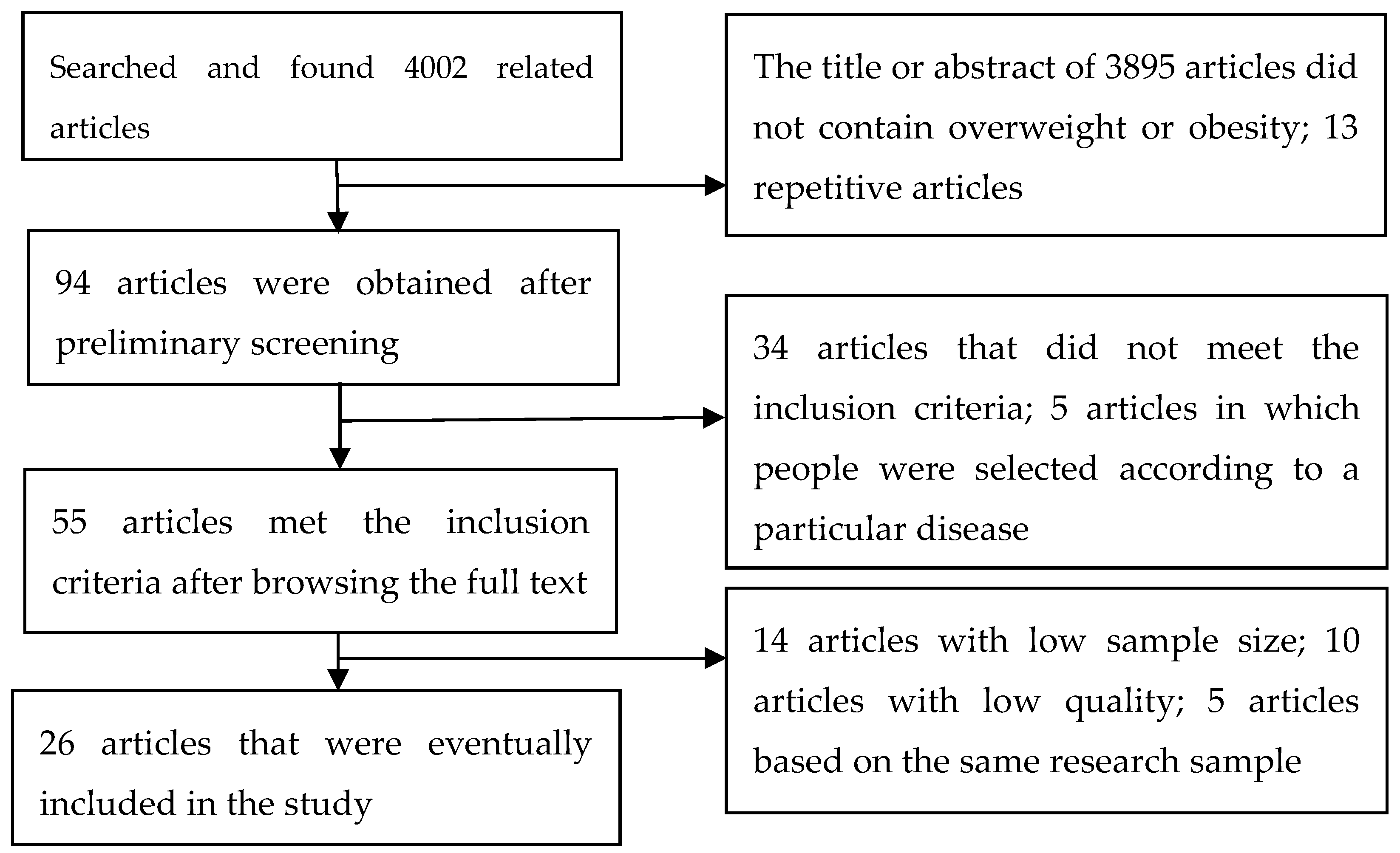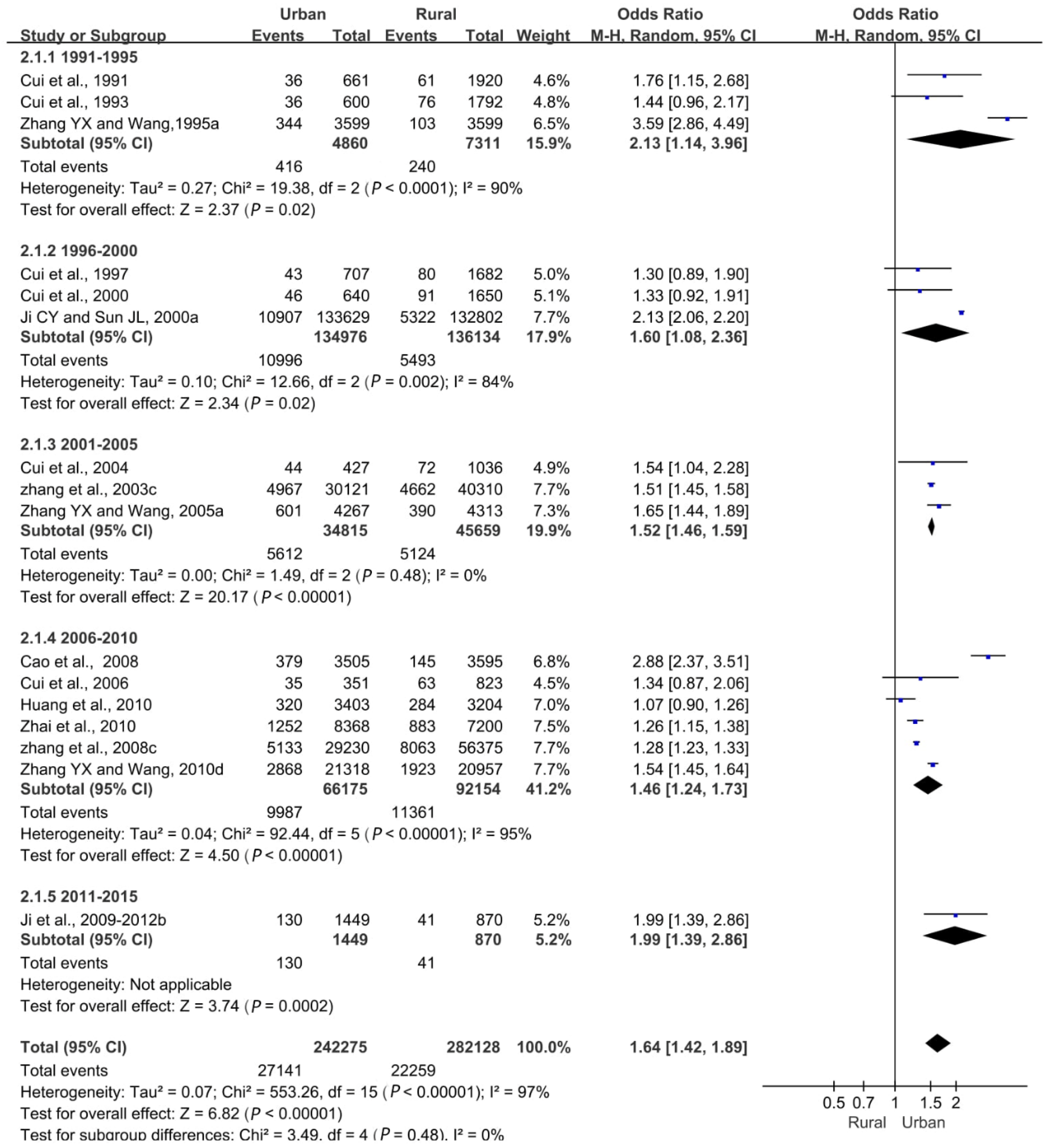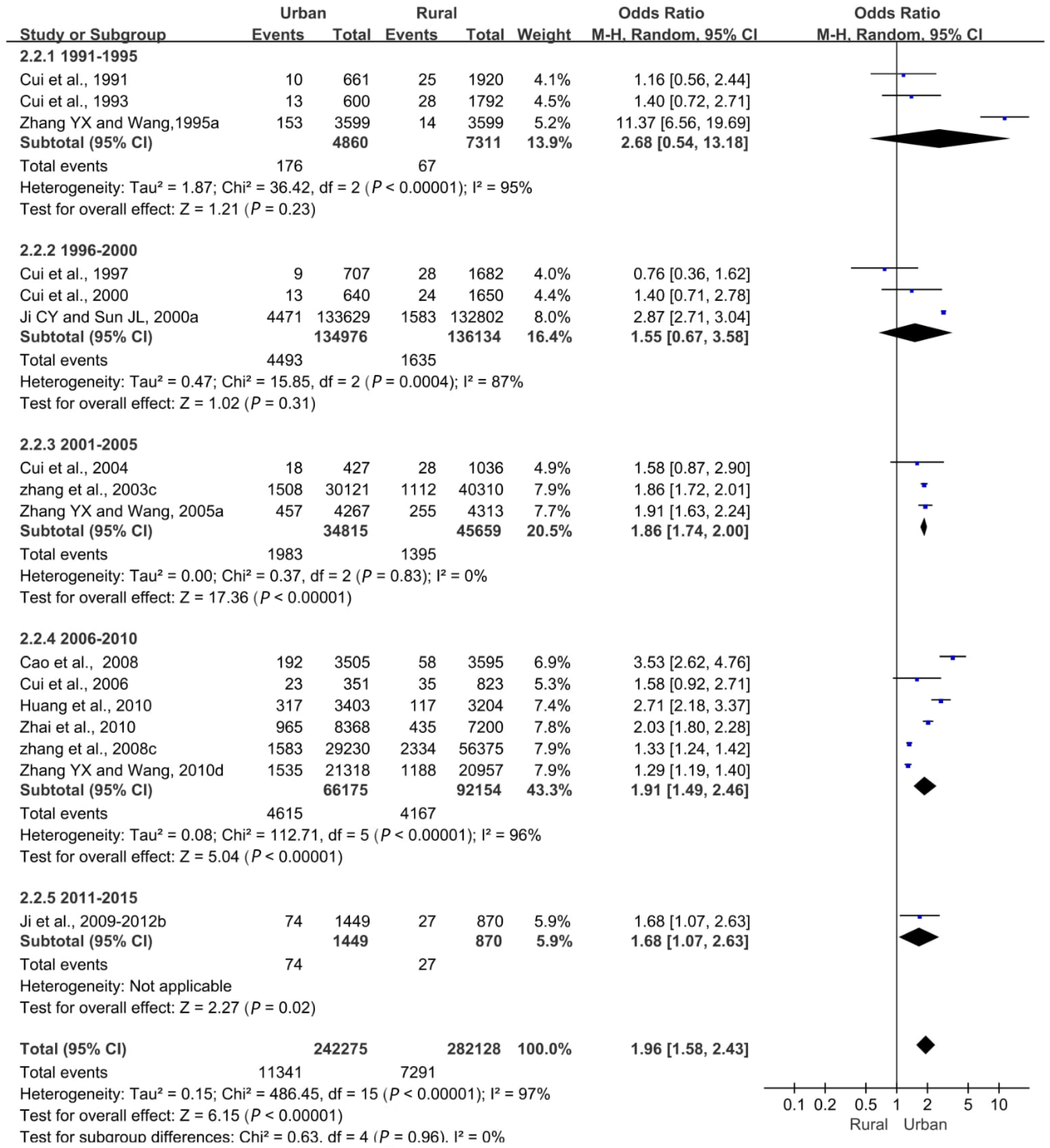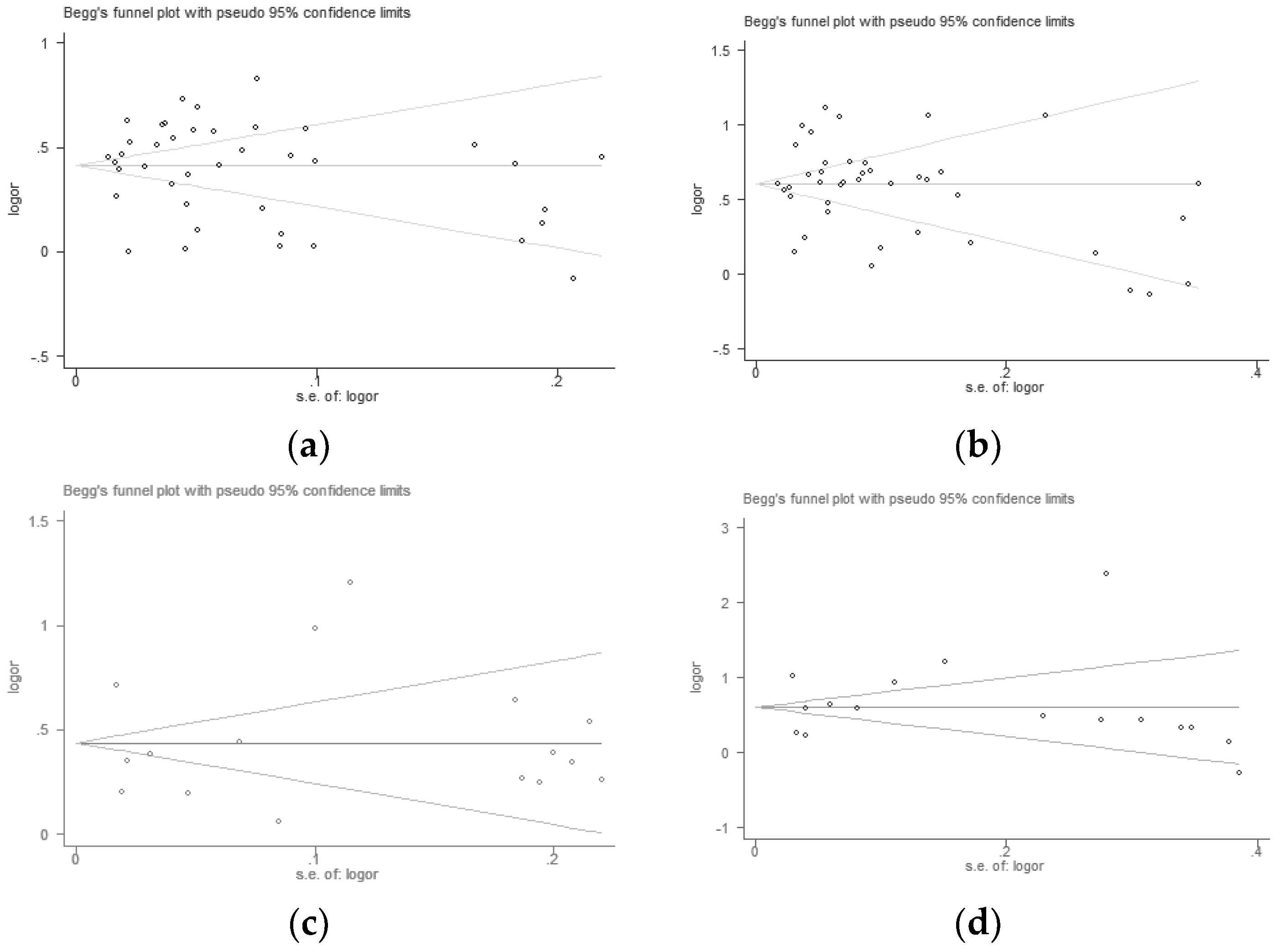Trends in Overweight and Obesity Among Children and Adolescents in China from 1991 to 2015: A Meta-Analysis
Abstract
1. Introduction
2. Materials and Methods
2.1. Literature Retrieval Strategy
2.2. Documentation Inclusion and Exclusion Criteria
2.2.1. Literature Inclusion Criteria
2.2.2. Literature Exclusion Criteria
2.3. Data Extraction
2.4. Statistical Analysis
3. Results
3.1. Included Document Characteristics
3.1.1. Literature Search Results
3.1.2. General Situation and Quality Evaluation of the Literature
3.2. Meta-Analysis Results
3.2.1. Prevalence of Overweight in Children and Adolescents
Sex Differences
Urban and Rural Differences
Differences in Growth and Development Stages
3.2.2. Prevalence Rate of Obesity in Children and Adolescents
Sex Differences
Urban and Rural Differences
Differences in Growth and Development Stages
3.3. Heterogeneity Test and Publication Bias
4. Discussion
5. Study Limitations
6. Conclusions
Supplementary Materials
Author Contributions
Funding
Acknowledgments
Conflicts of Interest
References
- Wang, Y.; Lobstein, T. Worldwide trends in childhood overweight and obesity. Int. J. Pediatr. Obes. 2006, 1, 11–25. [Google Scholar] [CrossRef] [PubMed]
- Ma, J.; Wu, S.S.; Li, B.H.; Wang, H.J.; Zhang, S.W.; Zhang, B. Investigation on Physical Activity Among Children and Adolescents with Different Nutritional Status in Five Cities in China. Chin. J. Sch. Health 2009, 30, 214–217. [Google Scholar]
- Ma, J.; Wu, S.S. Trend Analysis of the Prevalence of Obesity and Overweight Among School-age Children and Adolescents in China. Chin. J. Sch. Health 2009, 30, 195–197. [Google Scholar]
- Ma, J.; Cai, C.H.; Wang, H.J.; Dong, B.; Song, Y.; Hu, P.J.; Zhang, B. The trend analysis of overweight and obesity in Chinese students during 1985–2010. Chin. J. Prev. Med. 2012, 46, 776–780. [Google Scholar]
- Wang, S.; Dong, Y.H.; Wang, Z.H.; Zou, Z.Y.; Ma, J. Trends in overweight and obesity among Chinese children of 7–18 years old during 1985–2014. Chin. J. Prev. Med. 2017, 51, 300–305. [Google Scholar]
- The people’s Republic of China Ministry of health of maternal and child health care and Community health department. The Nattional Growth Survey of Children Under 7 Years in the Nine Cities of China; People’s Medical Publishing House (PMPH): Beijing, China, 2008; pp. 188–190.
- Wang, W.Q.; Zhao, Z.P.; Ma, Y.; Zhu, Y.; Hou, R.L.; Gao, X.Y. Nutritional Status of Village Students in Chang’an County, 1990–1999. Chin. J. Sch. Health 2003, 24, 39–40. [Google Scholar]
- Xie, S.N.; Wang, J.M.; Li, N.; Jiang, W.W.; Yang, S.B.; Li, X.; Ling, Z.Y.; Zhang, J. Survey on overweight and obesity of preschool children in rural areas from ten provinces of China. Chin. J. Epidemiol. 2014, 35, 425–428. [Google Scholar]
- Paradise, A.W.; Kernis, M.H. Self-esteem and psychological well-being: Implications of fragile self-esteem. J. Soc. Clin. Psychol. 2002, 21, 345–361. [Google Scholar] [CrossRef]
- Wang, F.; Wild, T.C.; Kipp, W.; Kuhle, S.; Veugelers, P.J. The influence of childhood obesity on the development of self-esteem. Health Rep. 2009, 20, 21–27. [Google Scholar]
- Peeters, A.; Barendregt, J.J.; Willekens, F.; Mackenbach, J.P.; Al Mamun, A.; Bonneux, L. Obesity in adulthood and its consequences for, life expectancy: A life-table analysis. Ann. Intern. Med. 2003, 138, 24–32. [Google Scholar] [CrossRef]
- Wu, Z.J.; Wang, Z.Y.; SongYan, L.Q. Meta-Analysis of Chinese Obese Adolescents Weight-losing Effect by Exercise. J. Shenyang Sport Univ. 2017, 36, 67–75. [Google Scholar]
- Group of China Obesity Task Force. Body mass index reference norm for screening overweight and obesity in Chinese children and adolescents. Chin. J. Epidemiol. 2004, 25, 97–102. [Google Scholar]
- Word Health Organization. Physical status: The use and interpretation of anthropometry. Report of a WHO Expert Committee. World Health Org. Tech. Rep. Ser. 1995, 854, 1–452. [Google Scholar]
- Cole, T.J.; Bellizzi, M.C.; Flegal, K.M.; Dietz, W.H. Establishing a standard definition for child overweight and obesity worldwide: International survey. Br. Med. J. 2000, 320, 1240–1243. [Google Scholar] [CrossRef] [PubMed]
- Kuczmarski, R.J.; Ogden, C.L.; Guo, S.S.; Grummer-Strawn, L.M.; Flegal, K.M.; Mei, Z.; Wei, R.; Curtin, L.R.; Roche, A.F.; Johnson, C.L. 2000 CDC Growth Charts for the United States: Methods and Development; Vital and Health Statistics. Series 11; National Health Survey: Hyattsville, MA, USA, 2002; pp. 1–190.
- Tzamaloukas, A.H.; Murata, G.H.; Hoffman, R.M.; Schmidt, D.W.; Hill, J.E.; Leger, A.; Macdonald, L.; Caswell, C.; Janis, L.; White, R.E. Classification of the degree of obesity by body mass index or by deviation from ideal weight. JPEN Parenter. Enter. Nutr. 2003, 27, 340–348. [Google Scholar] [CrossRef]
- Yu, Z.B.; Han, S.P.; Chu, J.H.; Xu, Z.Y.; Zhu, C.; Guo, X.R. Trends in Overweight and Obesity among Children and Adolescents in China from 1981 to 2010: A Meta-Analysis. PLoS ONE 2012, 7. [Google Scholar] [CrossRef]
- Higgins, J.; Thompson, S.G. Quantifying heterogeneity in a meta-analysis. Stat. Med. 2002, 21, 1539–1558. [Google Scholar] [CrossRef]
- Begg, C.B.; Mazumdar, M. Operating characteristics of a rank correlation test for publication bias. Biometrics 1994, 50, 1088–1101. [Google Scholar] [CrossRef]
- Ding, Z.Y.; He, Q.; Fan, Z.H.; Du, L.R.; Jiang, J.X.; Lu, X.Y.; Zheng, D.Y.; Zheng, H.L.; Yao, K.N.; Xie, P.; et al. National epidemiological study on obesity of children aged 0–7 years in china 1996. Natl. Med. J. China 1998, 78, 121–123. [Google Scholar]
- The National Task Force on Childhood Obesity and National Center for Women’s and Children’s Health. National epidemiological survey on childhood obesity, 2006. Chin. J. Pediatr. 2008, 46, 179–184. [Google Scholar]
- Cao, X.H.; Wang, H.J.; Yu, G.W. Prevalence of overweight and obesity of Lanzhou in 2008. Chin. J. Sch. Health 2011, 32, 695–696. [Google Scholar]
- Chen, Y.S.; Zhang, Y.M.; Kong, Z.X.; Yu, J.J.; Sun, T.T.; Zhang, H.Y. The prevalence of overweight and obesity in children and adolescents in China. Chin. J. Dis. Control Prev. 2017, 21, 866–869. [Google Scholar]
- Cui, Z.H.; Huxley, R.; Wu, Y.F.; Dibley, M.J. Temporal trends in overweight and obesity of children and adolescents from nine Provinces in China from 1991–2006. Int. J. Pediatr. Obes. 2010, 5, 365–374. [Google Scholar] [CrossRef] [PubMed]
- Li, Y.; Schouten, E.G.; Hu, X.; Cui, Z.; Luan, D.; Ma, G. Obesity prevalence and time trend among youngsters in China, 1982–2002. Asia Pac. J. Clin. Nutr. 2008, 17, 131–137. [Google Scholar]
- Wang, X.J.; Yang, Y.; Wu, Y.Q.; Peng, N.N. Study on epidemiological trend of overweight and obesity school-age children and adolescents over the past 29 years (1985–2014) in Shanghai, China. Chin. J. Evid. Based Pediatr. 2017, 12, 126–130. [Google Scholar]
- Gu, D.W.; Yang, B.C.; Ma, P. Trend analysis of overweight and obesity among children and adolescents in Jiangsu Province during 2005–2015. Chin. J. Sch. Health 2017, 38, 1540–1542. [Google Scholar]
- Huang, Z.Y.; BuRen, B.T.; HaSen, G.W.; Lin, Z.; Li, Y.S.; Zhang, Z.W.; Tong, W.J. Trends of overweight and obesity in aged 7 to 18 Mongolian ethnic children and adolescents from 1985–2010. Chin. J. Epidemiol. 2012, 33, 201–206. [Google Scholar]
- Ji, C.Y.; Sun, J.L. Prevalence of overweight and Obesity in Chinese students and its trend in the past 15 years. J. Peking Univ. 2004, 36, 194–197. [Google Scholar]
- Zhang, Y.X.; Wang, S.R. Distribution of body mass index and the prevalence changes of overweight and obesity among adolescents in Shandong, China from 1985 to 2005. Ann. Hum. Biol. 2008, 35, 547–555. [Google Scholar]
- Zhai, L.L.; Dong, Y.D.; Bai, Y.L.; Wei, W.; Jia, L.H. Trends in obesity, overweight, and malnutrition among children and adolescents in Shenyang, China in 2010 and 2014: A multiple cross-sectional study. BMC Public Health 2017, 17, 151. [Google Scholar] [CrossRef]
- Zhang, J.M.; Wang, J.; Zhu, J.F. Prevalence of obesity in 1–7-year-old children in Pudong New area of Shanghai. Anthol. Med. 2003, 22, 41–42. [Google Scholar]
- Wei, M. Epidemiological baseline survey of simple obesity among 6-year-old children in Shanghai in 2002. Shanghai J. Prev. Med. 2007, 19, 349–351. [Google Scholar]
- Xiong, F.; Zeng, Y.; Long, C.L.; Wang, D.G.; Zhu, M.; Luo, Y.H.; Luo, S.Q.; Lei, P.Y.; Deng, L.L.; Jiang, Y.C.; et al. Epidemiological survey of obesity and its related diseases in children and adolescents aged 3 to 18 years in Chongqing urban areas. Chongqing Med. 2005, 34, 1838–1840. [Google Scholar]
- Wang, J.L.; Wang, N.R. National epidemiological study on obesity children aged 0–18 years in Chongqing urban area. Chin. J. Child Health Care 2008, 16, 55–57. [Google Scholar]
- Zhang, M.Y.; Guo, F.X.; Tu, Y.Z.; Kiess, W.; Sun, C.J.; Li, X.; Lu, W.; Luo, F.H. Further increase of obesity prevalence in Chinese children and adolescents—Cross-sectional data of two consecutive samples from the city of Shanghai from 2003 to 2008. Pediatr. Diabetes 2012, 13, 572–577. [Google Scholar] [CrossRef] [PubMed]
- Niu, X.L.; Xu, H.X.; Zhao, S.T. Analysis of prevalence trend of overweight and obesity among children and adolescents of Hui Han nationality in Ningxia. Chin. J. Sch. Health 2016, 37, 1910–1912. [Google Scholar]
- Liu, B.Y.; Jing, J.; Mai, J.C.; Chen, Y.J.; Xu, G.F.; Bao, P.; Yu, M.Q.; Zhang, W.; Peng, Y.H. Secular trends of overweight and obesity prevalence between 2007 and 2011 in children and adolescents in Guangzhou. Chin. J. Prev. Med. 2014, 48, 312–317. [Google Scholar]
- Ji, G.Y.; Dun, Z.J.; Jiang, Q.; Wen, J.; Wang, P.; Huang, R.; Chen, Z.H.; Li, Z.H.; Ma, W.J.; Zhang, Y.H. Prevalence and trend of overweight and obesity in children and adolescents in Guangdong province, 2002–2012. Chin. J. Epidemiol. 2016, 37, 1242–1247. [Google Scholar]
- Gu, F.; Zhang, R.H.; Fang, Y.Q.; Hu, H.F.; Li, N. Prevalence of overweight and obesity among children and adolescents in Zhejiang Province. Chin. J. Sch. Health 2013, 34, 838–840. [Google Scholar]
- Jiang, X.X.; Hardy, L.L.; Baur, L.A.; Ding, D.; Wang, L.; Shi, H.J. High prevalence of overweight and obesity among inner city Chinese children in Shanghai, 2011. Ann. Hum. Biol. 2014, 41, 469–472. [Google Scholar] [CrossRef]
- Ma, L.; Mai, J.; Jing, J.; Liu, Z.; Zhu, Y.; Jin, Y.; Chen, Y. Empirical change in the prevalence of overweight and obesity in adolescents from 2007 to 2011 in Guangzhou, China. Eur. J. Pediatr. 2014, 173, 787–791. [Google Scholar] [CrossRef] [PubMed]
- Zhang, Y.X.; Wang, S.R. Prevalence and regional distribution of childhood overweight and obesity in Shandong Province, China. World J. Pediatr. 2013, 9, 135–139. [Google Scholar] [CrossRef] [PubMed]
- CPC Central Committee and Council. Views of the State Council of the CPC Central Committee on Strengthening the Physical Fitness of Adolescents. Available online: http://www.gov.cn/jrzg/2007-05/24/content_625090.htm (accessed on 5 November 2018).
- Lu, Y.Y.; Huang, Y.F. A Study on Typical Samples of Implement Achievements of Sunshine Athletic Sports. Zhejiang Sport Sci. 2011, 33, 63–66. [Google Scholar]
- General Administration of Sport of China. The Twelfth Five-Year Plan for the Development of Physical Education. Available online: http://www.sport.gov.cn/n16/n1077/n1467/n1843577/1843747.html (accessed on 5 November 2018).
- Xue, H.M.; Liu, Y.; Duan, R.N.; Zhou, X.; Cheng, G. Prevalence trend of overweight and Obesity in Chinese Children and adolescents and related influencing factors. Chin. J. Sch. Health 2014, 35, 1258–1262. [Google Scholar]
- Zhang, X. Status of obesity and its influencing factors among pupils in Changning District, Shanghai. Chin. J. Sch. Dr. 2012, 26, 189–190. [Google Scholar]
- Zhao, G.L.; Li, W.; Wang, W.Y. Study on Comprehensive Intervention for Obesity among Preschool Children. Chin. J. Soc. Med. 2014, 31, 204–206. [Google Scholar]
- O’Dea, J.A.; Caputi, P. Association between socioeconomic status, weight, age and gender, and the body image and weight control practices of 6-to 19-year-old children and adolescents. Health Educ. Res. 2001, 16, 521–532. [Google Scholar] [CrossRef]
- Mak, K.K.; Pang, J.S.; Lai, C.M.; Ho, R.C. Body esteem in Chinese adolescents: Effect of gender, age, and weight. J. Health Psychol. 2013, 18, 46–54. [Google Scholar] [CrossRef]
- Shi, Z.M.; Lien, N.N.; Kumar, B.N.; Holmboe-Ottesen, G. Perceptions of weight and associated factors of adolescents in Jiangsu Province, China. Public Health Nutr. 2007, 10, 298–305. [Google Scholar] [CrossRef]
- Ye, W.X. Investigation of nutritional status of students in elementary and middle school in Heyuan city. Chin. J. Dis. Control Prev. 2006, 10, 317–318. [Google Scholar]
- Ji, C.Y. A Comprehensive Survey of Health-Related Risk Behaviors among Adolescents in China 2005; Peking University Medical Press: Beijing, China, 2007. [Google Scholar]
- Song, Y.; Ma, J.; Wang, H.J.; Wang, Z.Q.; Hu, P.J.; Zhang, B.; Agard, A. Secular Trends of Obesity Prevalence in Chinese Children from 1985 to 2010: Urban-Rural Disparity. Obesity 2015, 23, 448–453. [Google Scholar] [CrossRef] [PubMed]
- Bovet, P.; Chiolero, A.; Shamlaye, C.; Paccaud, F. Prevalence of overweight in the Seychelles: 15 year trends and association with socio-economic status. Obes. Rev. 2008, 9, 511–517. [Google Scholar] [CrossRef] [PubMed]
- Cheng, T.O. Fast food, automobiles, television and obesity epidemic in Chinese children. Int. J. Cardiol. 2005, 98, 173–174. [Google Scholar] [CrossRef] [PubMed]
- Davis, A.M.; Bennett, K.J.; Befort, C.; Nollen, N. Obesity and Related Health Behaviors Among Urban and Rural Children in the United States: Data from the National Health and Nutrition Examination Survey 2003–2004 and 2005–2006. J. Pediatr. Psychol. 2011, 36, 669–676. [Google Scholar] [CrossRef] [PubMed]
- Sjoberg, A.; Moraeus, L.; Yngve, A.; Poortvliet, E.; Al-Ansari, U.; Lissner, L. Overweight and obesity in a representative sample of schoolchildren—Exploring the urban-rural gradient in Sweden. Obes. Rev. 2011, 12, 305–314. [Google Scholar] [CrossRef] [PubMed]
- Zhang, X.Y.; van der Lans, I.; Dagevos, H. Impacts of fast food and the food retail environment on overweight and obesity in China: A multilevel latent class cluster approach. Public Health Nutr. 2012, 15, 88–96. [Google Scholar] [CrossRef]
- Yin, X.J.; Jia, L.Q.; Gao, X.D.; Guo, Q. Comparative Study of Physical Fitness between Migrant Workers’ School Children and Those of the Shanghai Natives. J. Chengdu Sport Univ. 2011, 37, 66–69. [Google Scholar]
- Dong, G.H.; Qian, Z.M.; Liu, M.M.; Wang, D.; Ren, W.H.; Flick, L.H.; Fu, J.; Wang, J.; Chen, W.; Simckes, M.; et al. Ambient Air Pollution and the Prevalence of Obesity in Chinese Children: The Seven Northeastern Cities Study. Obesity 2014, 22, 795–800. [Google Scholar] [CrossRef]
- Zhang, Y.X.; Wang, Z.X.; Zhao, J.S.; Chu, Z.H. Trends in overweight and obesity among rural children and adolescents from 1985 to 2014 in Shandong, China. Eur. J. Prev. Cardiol. 2016, 23, 1314–1320. [Google Scholar] [CrossRef]
- Chen, M.X.; Liu, W.D.; Tao, X.L. Evolution and assessment on China’s urbanization 1960–2010: Under-urbanization or over-urbanization? Habitat Int. 2013, 38, 25–33. [Google Scholar] [CrossRef]
- Chen, Y.H.; Mao, H.F. Analysis of overweight and Obesity in 0–2-year-old infants in Yinzhou District and its influencing factors. Chin. J. Prev. Control Chronic Dis. 2018, 26, 31–33. [Google Scholar]
- Wang, N.R.; Huang, J.; Li, K.P.; Zhao, Y.; Wen, J.; Ye, Y.; Fan, X. Prevalence and risk factors of overweight and obesity among infants in Chongqing urban area. Chin. J. Contemp. Pediatr. 2013, 15, 207–211. [Google Scholar]
- Yu, H.; Chen, X.X.; Liu, D. Influencing factors and epidemic status of overweight and obesity of infants under 3 years of age in Shaoxing. Chin. J. Child Health Care 2012, 20, 749–750. [Google Scholar]
- Levine, J.A. Obesity in China: Causes and solutions. Chin. Med. J. Peaking 2008, 121, 1043–1050. [Google Scholar] [CrossRef]
- De Onis, M.; Blössner, M.; Borghi, E. Global prevalence and trends of overweight and obesity among preschool children. Am. J. Clin. Nutr. 2010, 92, 1257–1264. [Google Scholar] [CrossRef]
- Kelishadi, R.; Haghdoost, A.; Sadeghirad, B.; Khajehkazemi, R. Trend in the prevalence of obesity and overweight among Iranian children and adolescents: A systematic review and meta-analysis. Nutrition 2014, 30, 393–400. [Google Scholar] [CrossRef]
- Tang, Q.; Chen, S.K.; Luo, J.S.; Fan, X.; Feng, Y. Epidemiologic status and influencing factors of obesity in children and adolescents. Chin. J. Child Health Care 2011, 19, 1014–1017. [Google Scholar]
- Yan, J.; Liu, L.; Zhu, Y.; Huang, G.W.; Wang, P.P. The association between breastfeeding and childhood obesity: A meta-analysis. BMC Public Health 2014, 14, 1267. [Google Scholar] [CrossRef]
- Gong, Q.H.; Zhang, X.H. Meta-analysis of the association between breastfeeding and children’s obesity. Chin. J. Child Health Care 2009, 17, 38–40. [Google Scholar]
- Kral, T.V.E.; Rauh, E.M. Eating behaviors of children in the context of their family environment. Physiol. Behav. 2010, 100, 567–573. [Google Scholar] [CrossRef]






| Author, Year | Time Period | Sample Size | Age (Years) | Criteria | Target Population | Grade | Overweight, Prevalence, % | Obesity, Prevalence, % |
|---|---|---|---|---|---|---|---|---|
| National Survey on Childhood Obesity (NSCO) | ||||||||
| Ding et al., 1998 [21] | 1996 | 208,513 | 0–7 | NCHS/CDC | Urban children | 15 | 4.2 | 2.1 |
| NTFCOC, 2008 [22] | 2006 | 84,766 | 0–7 | W/IW (WHO) | Urban children | 15 | 19.8 | 7.2 |
| Xie et al., 2014 [8] | 2006 | 38,923 | 3–7 | BMI(WHO) | Rural | 13 | 4.2 | 1.2 |
| Cao et al., 2011 [23] | 2008 | 7100 | 7–18 | BMI (WGOC) | Urban/rural | 15 | 7.4 | 3.5 |
| Chen et al., 2017 [24] | 2013 | 120,275 | 7–18 | BMI (WGOC) | Urban/rural | 16 | 12.2 | 7.2 |
| China Health and Nutrition Survey (CHNS) | ||||||||
| Cui et al., 2010 [25] | 1991/1993/1997/ 2000/2004/2006 | 2581/2392/2389/ 2290/1463/1174 | 7–17 | BMI (WGOC) | Urban/rural | 13 | 3.8/4.7/5.1/ 5.9/7.9/8.3 | 1.4/1.7/1.6/ 1.6/3.1/4.9 |
| Chinese National Nutrition and Health Survey (CNNHS) | ||||||||
| Li et al., 2008 [26] | 1992/2002 | 15,501/44,880 | 7–17 | BMI(WHO) | Urban/rural | 17 | 3.7/4.4 | 0.9/0.9 |
| Chinese National Survey on Children Constitution and Health (CNSCCH) | ||||||||
| Wang et al., 2017a [27] | 1995/2005/2010 | 7916/7492/14,301 | 7–18 | BMI (WGOC) | Not reported | 14 | 7.1/11.2/13.9 | 2.6/3.7/7.0 |
| Gu et al., 2017a [28] | 2005/2010 | 18,524/21,701 | 7–18 | BMI (WGOC) | Urban/rural | 14 | 10.7/12.2 | 5.0/5.5 |
| Huang et al., 2012 [29] | 2010 | 6607 | 7–18 | BMI (WGOC) | Urban/rural | 15 | 9.1 | 6.6 |
| Ji CY and Sun JL, 2005a [30] | 2000 | 266,431 | 7–18 | BMI (WGOC) | Urban/rural | 17 | 6.1 | 2.3 |
| Wang et al., 2017b [5] | 2014 | 214,354 | 7–18 | BMI (WGOC) | Urban/rural | 17 | 12.1 | 7.3 |
| Zhang YX and Wang SR, 2008a [31] | 1995/2005 | 7198/8580 | 7–18 | BMI (WGOC) | Urban/rural | 15 | 6.2/11.6 | 2.3/8.3 |
| Zhai et al., 2017 [32] | 2010 | 15,568 | 7–18 | BMI (WGOC) | Urban/rural | 16 | 13.7 | 9.0 |
| Regional Survey on Childhood Obesity (RSCO) | ||||||||
| Zhang et al., 2003b [33] | 2002 | 6088 | 1–7 | W/IW(WHO) | Urban/rural | 12 | 7.2 | 4.2 |
| Wei, 2007 [34] | 2002 | 58,030 | 0–6 | W/IW(WHO) | Urban | 12 | 4.8 | |
| Xiong et al., 2005 [35] | 2004 | 23,292 | 3–18 | BMI (IOTF) | Urban | 12 | 12.4 | 3.7 |
| Wang JL and Wang NR, 2008c [36] | 2006 | 18,320 | 0–18 | BMI (CDC) | Urban | 12 | 13.4 | 8.3 |
| Zhang et al., 2012c [37] | 2003/2008 | 70,431/85,605 | 6–18 | BMI (IOTF) | Rurban | 12 | 13.7/15.4 | 3.7/4.6 |
| Niu et al., 2016 [38] | 2005/2014 | 4956/5308 | 7–18 | BMI (WGOC) | Urban/rural | 14 | 5.9/10.5 | 2.2/5.1 |
| Liu et al., 2014 [39] | 2007/2011 | 27,944/38,284 | 5–18 | BMI (WGOC) | Not reported | 11 | 10.3/10.9 | 6.4/6.9 |
| Ji et al., 2016b [40] | 2009-2012 | 2319 | 6–17 | BMI(WHO/WGOC) | Urban/rural | 11 | 7.1 | 4.4 |
| Gu et al., 2013b [41] | 2011 | 33,256 | 7–18 | BMI (WGOC) | Not reported | 12 | 10.6 | 5.3 |
| Jiang et al., 2014 [42] | 2011 | 5902 | 8–15 | BMI (IOTF) | Not reported | 11 | 16.4 | 11.6 |
| Ma et al., 2014 [43] | 2007/2009/2011 | 17,157/26,381/36,328 | 12–18 | BMI (WGOC) | Not reported | 12 | 8.1/9.6/9.9 | 3.1/4.7/4.2 |
| Zhang YX and Wang SR, 2013d [44] | 2010 | 42,275 | 7–18 | BMI (IOTF) | Urban/rural | 11 | 13.5 | 4.3 |
| Time Period | Infancy (Age 0–1 Years) | Toddlers (Age 1–3 Years) | Preschool Children (Age 4–6 Years) | School Children (Age 7–13 Years) | Adolescents (Age 14–18 Years) |
|---|---|---|---|---|---|
| 1991–1995 | - | - | - | 4.2 (3.8–4.5) | 3.3 (2.9–3.7) |
| 1996–2000 | 4.7 (4.5–5) | 1.4 (1.3–1.5) | 1.9 (1.8–2.0) | 6.0 (5.9–6.2) | 6.3 (6.1–6.4) |
| 2001–2005 | - | 9.7 (8.1–11.2) | 11.8 (10.8–12.9) | 6.6 (6.4–6.8) | 7.1 (6.8–7.5) |
| 2006–2010 | 19.4 (18.9–19.9) | 17.6 (17.3–18) | 11.0 (10.7–11.2) | 13.4 (13.2–13.7) | 9.1 (8.9–9.3) |
| 2011–2015 | - | - | 7.5 (6.5–8.5) | 12.8 (12.6–13) | 10.2 (10.0–10.4) |
| Total | 11.7 (11.4–11.9) | 7.4 (7.2–7.5) | 5.6 (5.5–5.7) | 9.7 (9.6–9.7) | 8.2 (8.1–8.3) |
| Time Period | Infancy | Toddlers | Preschool Children | School Children | Adolescents |
|---|---|---|---|---|---|
| 1991–1995 | - | - | - | 1.7 (1.4–1.9) | 0.3 (0.2–0.4) |
| 1996–2000 | 8.3 (8.0–8.7) | 4.2 (4.0–4.3) | 3.1 (3.0–3.2) | 2.8 (2.7–2.9) | 1.8 (1.7–1.8) |
| 2001–2005 | 4.5 (4.1–5.0) | 2.1 (1.9–2.2) | 6.6 (6.4–6.9) | 1.8 (1.7–1.9) | 1.6 (1.4–1.8) |
| 2006–2010 | 6.3 (5.9–6.6) | 5.0 (4.8–5.2) | 5.3 (5.1–5.4) | 7.5 (7.3–7.7) | 3.5 (3.4–3.6) |
| 2011–2015 | - | - | 11.3 (10.0–12.5) | 8.9 (8.7–9.1) | 3.9 (3.7–4.0) |
| Total | 7.0 (6.8–7.2) | 4.1 (4.0–4.2) | 4.5 (4.4–4.6) | 5.5 (5.4–5.6) | 2.8 (2.7–2.9) |
© 2019 by the authors. Licensee MDPI, Basel, Switzerland. This article is an open access article distributed under the terms and conditions of the Creative Commons Attribution (CC BY) license (http://creativecommons.org/licenses/by/4.0/).
Share and Cite
Guo, Y.; Yin, X.; Wu, H.; Chai, X.; Yang, X. Trends in Overweight and Obesity Among Children and Adolescents in China from 1991 to 2015: A Meta-Analysis. Int. J. Environ. Res. Public Health 2019, 16, 4656. https://doi.org/10.3390/ijerph16234656
Guo Y, Yin X, Wu H, Chai X, Yang X. Trends in Overweight and Obesity Among Children and Adolescents in China from 1991 to 2015: A Meta-Analysis. International Journal of Environmental Research and Public Health. 2019; 16(23):4656. https://doi.org/10.3390/ijerph16234656
Chicago/Turabian StyleGuo, Yaru, Xiaojian Yin, Huipan Wu, Xiaojiang Chai, and Xiaofang Yang. 2019. "Trends in Overweight and Obesity Among Children and Adolescents in China from 1991 to 2015: A Meta-Analysis" International Journal of Environmental Research and Public Health 16, no. 23: 4656. https://doi.org/10.3390/ijerph16234656
APA StyleGuo, Y., Yin, X., Wu, H., Chai, X., & Yang, X. (2019). Trends in Overweight and Obesity Among Children and Adolescents in China from 1991 to 2015: A Meta-Analysis. International Journal of Environmental Research and Public Health, 16(23), 4656. https://doi.org/10.3390/ijerph16234656





